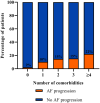Multimorbidity Is Associated With Symptom Severity and Disease Progression in Patients with Paroxysmal Atrial Fibrillation-Data From the RACE V Study
- PMID: 40008502
- PMCID: PMC12132691
- DOI: 10.1161/JAHA.123.034514
Multimorbidity Is Associated With Symptom Severity and Disease Progression in Patients with Paroxysmal Atrial Fibrillation-Data From the RACE V Study
Abstract
Background: Multimorbidity is common among patients with atrial fibrillation (AF) and is associated with worse outcomes. We aimed to investigate the association between multimorbidity, AF progression and AF symptom severity in patients with paroxysmal AF.
Methods and results: The RACE V (Reappraisal of AF: Interaction Between Hypercoagulability, Electrical Remodeling, and Vascular Destabilization in the Progression of AF) study included patients with paroxysmal AF and continuous rhythm monitoring. Multimorbidity was defined as ≥2 comorbidities (heart failure, hypertension, diabetes, coronary heart disease, kidney dysfunction, moderate or severe mitral valve regurgitation, or obesity). AF symptom severity was assessed via the University of Toronto AF Severity Scale questionnaire. The associations between multimorbidity, AF progression, and AF symptom severity were determined using logistic regression analyses. Median age was 65 (58-71) years and 179 of 417 patients (43%) were women, with a median of 1 (1-2) comorbidities. Median follow-up was 2.2 (1.6-2.8) years. Multimorbidity was associated with AF progression (odds ratio [OR], 2.02 [95% CI, 1.10-3.72], P=0.024) and increased AF symptom severity (OR, 2.67 [95% CI, 1.79-3.99], P<0.001). There was a positive dose-response relation between the number of comorbidities and AF progression (OR, 1.40 [95% CI, 1.09-1.79], P=0.008), as well as AF symptom severity (OR, 1.64 [95% CI, 1.35-1.99], P<0.001). These results remained significant after adjusting for age.
Conclusions: In patients with paroxysmal AF, multimorbidity was associated with AF progression and AF symptom severity. The risk of AF progression and AF symptom severity increased with every additional comorbidity.
Registration: URL: clinicaltrials.gov. Unique Identifier: NCT02726698.
Keywords: atrial fibrillation; comorbidities; multimorbidity; progression; symptom severity.
Figures





References
-
- Padfield GJ, Steinberg C, Swampillai J, Qian H, Connolly SJ, Dorian P, Green MS, Humphries KH, Klein GJ, Sheldon R, et al. Progression of paroxysmal to persistent atrial fibrillation: 10‐year follow‐up in the Canadian Registry of Atrial Fibrillation. Heart Rhythm. 2017;14:801–807. doi: 10.1016/j.hrthm.2017.01.038 - DOI - PubMed
-
- Proietti M, Vitolo M, Harrison SL, Lane DA, Fauchier L, Marin F, Nabauer M, Potpara TS, Dan GA, Boriani G, et al. Impact of clinical phenotypes on management and outcomes in European atrial fibrillation patients: a report from the ESC‐EHRA EURObservational Research Programme in AF (EORP‐AF) General Long‐Term Registry. BMC Med. 2021;19:1–17. doi: 10.1186/s12916-021-02120-3 - DOI - PMC - PubMed
-
- Claxton JNS, Chamberlain AM, Lutsey PL, Chen LY, MacLehose RF, Bengtson LGS, Alonso A. Association of multimorbidity with cardiovascular endpoints and treatment effectiveness in patients 75 years and older with atrial fibrillation. Am J Med. 2020;133:e554–e567. doi: 10.1016/j.amjmed.2020.03.038 - DOI - PMC - PubMed
MeSH terms
Associated data
LinkOut - more resources
Full Text Sources
Medical

